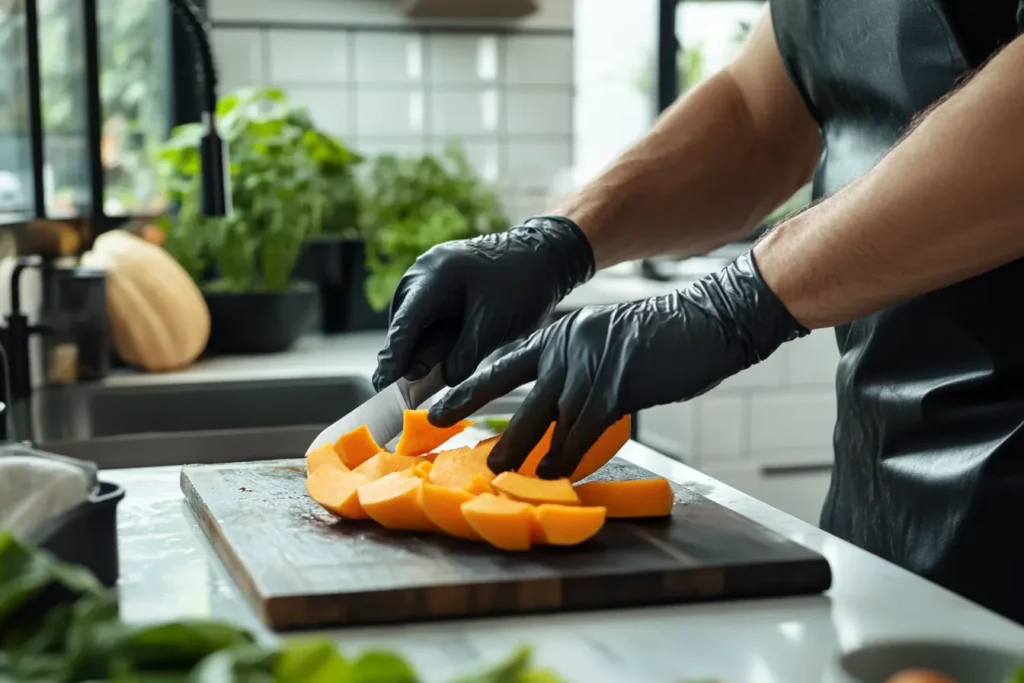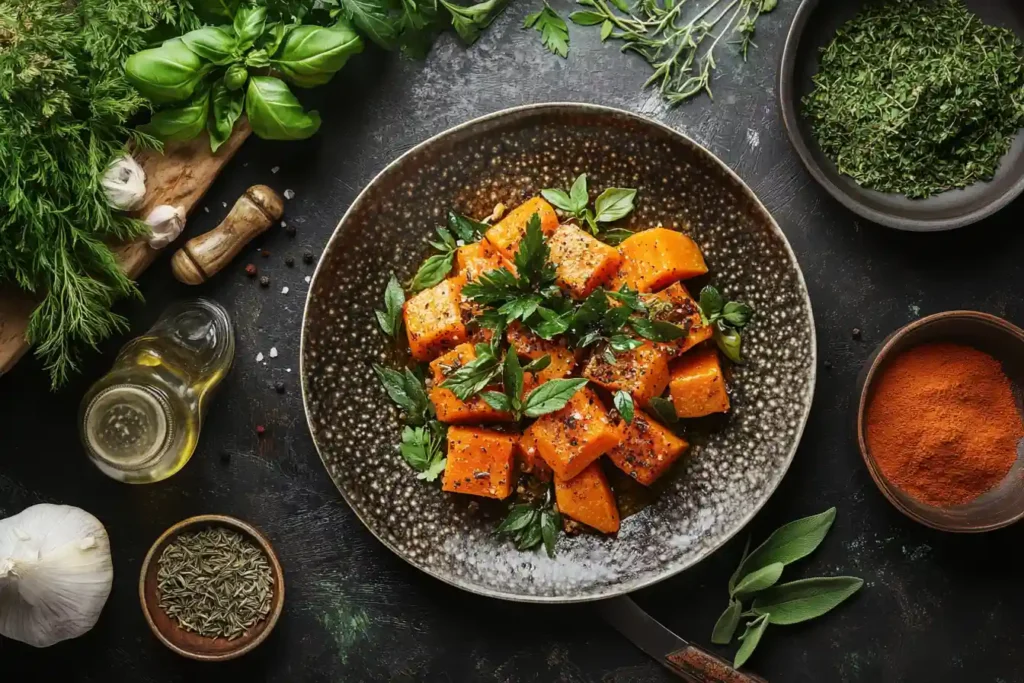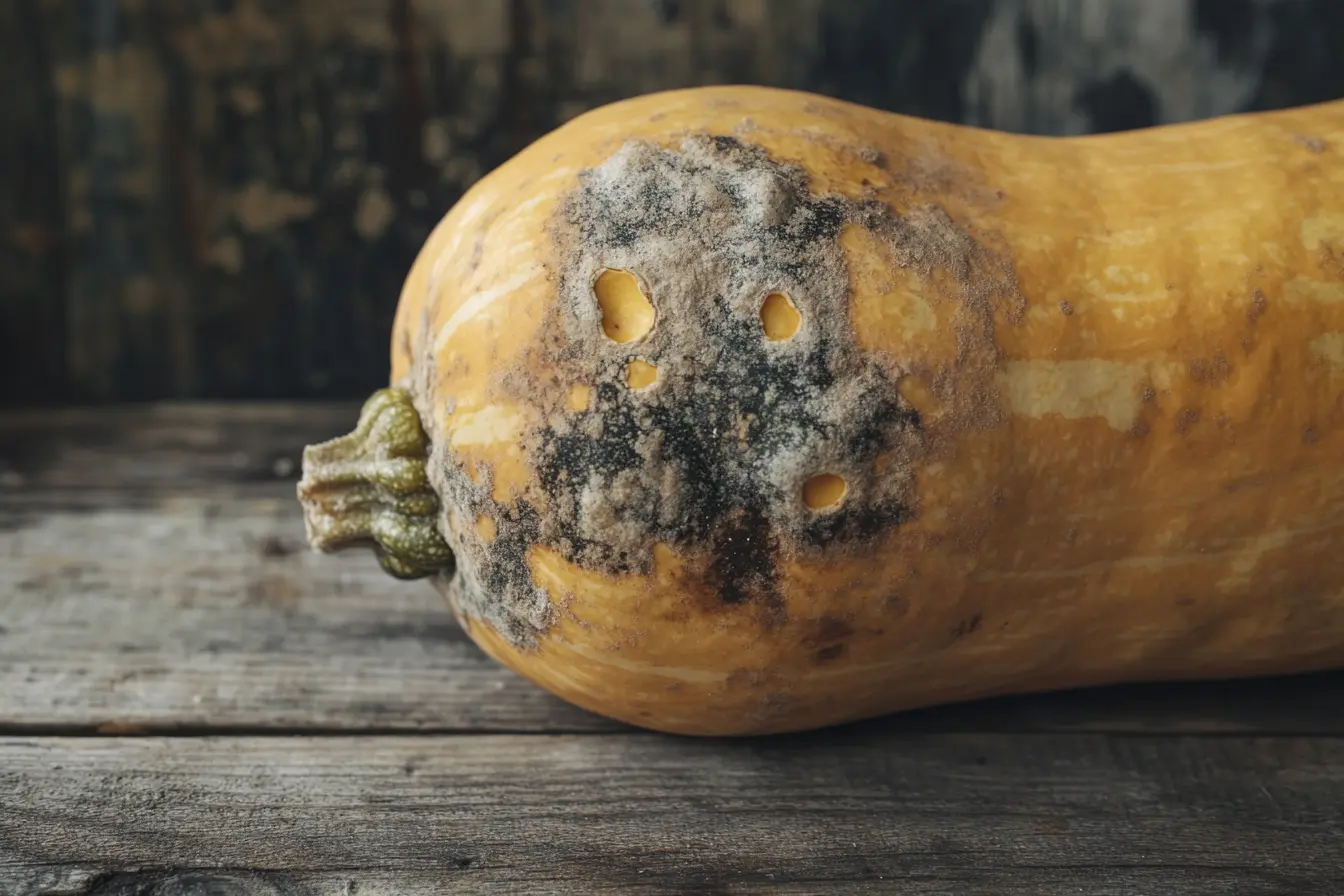When Should You Not Eat Butternut Squash? This article explores signs of spoilage, potential health concerns, and specific situations where it’s best avoided.
Butternut squash is a popular and nutritious food. However, there are times when it’s best to avoid it. Knowing when not to eat it is important. This helps prevent potential health issues. Let’s explore these situations in detail.
Table of contents
Recognizing Spoilage: When Should You Not Eat Butternut Squash
It’s important to know when butternut squash has gone bad. Eating spoiled squash can lead to illness. Therefore, knowing the signs of spoilage is key. Always check for visual cues before consuming.
Signs of a Spoiled Butternut Squash
- Soft Spots: If the squash has soft or mushy areas, avoid it. These areas indicate decay, where the flesh is breaking down.
- Mold: Look for any signs of mold. Mold can appear as fuzzy or discolored patches, typically white, green, or black.
- Unpleasant Smell: A bad odor suggests spoilage. Fresh squash has a mild, sweet scent, so any foul or sour smell indicates it’s not safe to eat.
- Wrinkled Skin: If the skin looks very wrinkled and shriveled, it’s likely old and dehydrated. The skin may also feel loose and less firm.
- Leaks or Weeping: Any signs of liquid oozing from the squash indicates decay. This liquid is often a result of the internal flesh breaking down.
- Internal Discoloration: If when cut, the flesh has dark spots or unusual colors, it may be spoiled. Healthy flesh is a vibrant orange color, so any dark or unusual colors are a sign it’s not fresh.
Spoilage Signs Checklist:
| Sign | Description | Action |
| Soft Spots | Mushy or soft areas, indicating the flesh is breaking down | Avoid eating |
| Mold | Fuzzy or discolored patches, typically white, green, or black | Discard |
| Unpleasant Smell | Foul or sour odor, unlike the mild, sweet smell of fresh squash | Discard |
| Wrinkled Skin | Very shriveled and dehydrated skin that may feel loose | Avoid eating |
| Leaks/Weeping | Liquid oozing from the squash, a sign of internal breakdown | Discard |
| Internal Discoloration | Dark spots or unusual colors in the flesh, indicating decay instead of a vibrant orange color | Avoid eating |
Storing Butternut Squash Correctly
Proper storage prolongs the life of butternut squash. Storing it correctly prevents spoilage. Indeed, this helps maintain its freshness and flavor. Follow these tips for optimal storage.
- Cool, Dry Place: Store whole squash in a cool, dry place, ideally between 50-60°F (10-15°C). This prevents moisture build-up, which can cause rot and decay.
- Avoid Direct Sunlight: Direct sun can cause spoilage by accelerating the ripening process and causing the squash to break down more quickly.
- Cut Squash: Wrap cut pieces tightly in plastic wrap or store them in an airtight container. Place them in the fridge and consume within a few days to maintain quality and avoid spoilage.
- Do Not Wash: Wait to wash the squash until right before use. Washing beforehand adds moisture, which can lead to faster decay and mold growth.
Storage Guidelines:
- Whole Squash:
- Cool, dry place: Temperature between 50-60°F (10-15°C)
- Avoid direct sunlight: Prevents accelerated breakdown
- Cut Squash:
- Wrap tightly in plastic wrap or use an airtight container: Preserves moisture and prevents contamination
- Store in fridge: Maintains freshness
- Use within a few days: Prevents spoilage
- Washing:
- Wash right before use: Avoids excess moisture
Health Concerns: When Should You Not Eat Butternut Squash
While butternut squash is generally healthy, certain health concerns can make it unsuitable. Understanding these concerns is important. Therefore, knowing when to avoid it helps protect your health. Some people may experience side effects.
Health Concerns Summary:
| Condition | Reason | Symptoms/Risks | Recommendation |
| Allergies/Sensitivities | Body’s immune response or sensitivity to compounds in squash | Itching, hives, digestive issues (such as nausea, diarrhea), bloating, gas, stomach pain | Consult a doctor for diagnosis and allergy testing; avoid if allergic; if sensitive eat smaller portions and monitor symptoms |
| Digestive Issues | High fiber content may cause discomfort for some individuals | Bloating, gas, stomach pain, increased bowel movements, discomfort, potential for diarrhea or constipation | Eat smaller portions and monitor your body’s response; increase fiber intake slowly; drink plenty of water |
| Medication Interactions | Certain medications, particularly blood thinners or blood pressure meds, may interact with compounds in squash | Potential changes in medication effectiveness, increased or decreased drug action, potential for side effects, altered blood clotting | Consult with a healthcare provider about potential interactions and dose adjustments; monitor for any changes while eating squash |
Allergies and Sensitivities
Some individuals may have natural allergies or sensitivities. Consequently, they should avoid butternut squash. Initially, these reactions might include itching, hives, or digestive problems. If you suspect an allergy, talk to a doctor.
Allergies and Sensitivities:
- Allergy Symptoms:
- Itching all over the body
- Hives, or red and bumpy rashes on the skin
- Digestive issues, such as nausea, vomiting, or diarrhea
- Sensitivity Symptoms:
- Bloating, or swelling in the stomach area
- Gas, including increased flatulence
- Stomach pain or cramps
- Recommendation:
- Consult a doctor for diagnosis and allergy testing
Digestive Issues
Butternut squash is high in fiber. Accordingly, while fiber is good for most, it can cause bloating or gas in some people. Those with sensitive digestive systems should eat squash in smaller amounts. This helps minimize discomfort.
Digestive Concerns:
- Fiber Content: High fiber can cause digestive issues
- Sensitive Systems: Individuals with IBS, Crohn’s, or colitis should proceed with caution
- Smaller Portions: Helps manage discomfort, especially when first adding to your diet
- Symptoms:
- Bloating, or swelling of the abdomen
- Gas, including increased flatulence
- Stomach pain, cramps, or discomfort
- May contribute to diarrhea or constipation
- Note: Individual reactions vary; monitor for symptoms
Interactions with Certain Medications
Certain medications may interact with foods like butternut squash. Specifically, medications for blood thinning (anticoagulants) or blood pressure (antihypertensives) could be affected. Therefore, consult a healthcare provider if you’re on medication. Moreover, this step ensures your diet is harmonious with your health needs.
Medication Interactions:
- Affected Medications:
- Blood thinners or anticoagulants, like Warfarin.
- Blood pressure medications, known as antihypertensives.
- Recommendation:
- Consult a healthcare provider to check for potential interactions
- Carefully manage diet and medications, potentially including dose adjustments
Specific Situations: When Should You Not Eat Butternut Squash
Certain life stages or conditions might require you to limit butternut squash intake. Recognizing these situations is important. Therefore, you can make better choices for your health.
Limiting Intake During Pregnancy
Pregnant women often need to adjust their diets. While butternut squash offers many nutrients, some women might experience discomfort. Therefore, monitor your body’s response, as each woman may react differently. Indeed, consult a doctor or dietitian for personalized guidance on dietary adjustments during pregnancy.
Kidney Problems
Those with kidney issues often must limit their potassium intake. Butternut squash is high in potassium. Thus, it may not be suitable for those with kidney problems, particularly when kidneys cannot efficiently filter potassium from the blood. Specifically, limit or avoid it based on your health needs, while consulting with a renal dietitian or doctor.
Infants and Young Children
When introducing new foods to infants, proceed slowly. Butternut squash is generally okay for babies, but monitor for reactions. Consequently, offer small amounts at first, starting with purees to ensure easy digestion. Furthermore, watch for any signs of allergies or sensitivities, such as rash, hives, or digestive upset. Accordingly, consult a pediatrician for advice, especially when introducing solids to infants.
Specific Situation Guidelines:
| Situation | Recommendation |
| Pregnancy | Monitor your body’s response closely, and consult with a doctor or registered dietitian for personalized guidance |
| Kidney Problems | Limit or avoid due to high potassium content, depending on kidney function; seek advice from your doctor or renal dietitian |
| Infants/Young Children | Introduce slowly, in small portions, starting with purees; monitor for reactions, and consult with a pediatrician |
Butternut Squash and Blood Pressure: What to Consider
Butternut squash is often recommended for its potassium content. Potassium helps regulate blood pressure by balancing the effects of sodium. However, it’s important to eat it as part of a balanced diet that is low in sodium and unhealthy fats. Additionally, if you have any concerns, talk to a doctor to manage your diet.
High Potassium Levels
While beneficial for most, high potassium (hyperkalemia) can be dangerous for certain individuals. Especially, those with kidney disease, certain heart conditions, or people taking specific medications. Monitor your potassium intake carefully and work with a doctor for a specific, tailored dietary plan. Consult with your doctor if you are at risk for high potassium.
Potassium and Blood Pressure:
- Benefit: Potassium can help regulate blood pressure by balancing sodium.
- Balanced Approach: Important to include in an overall eating pattern.
- High Potassium Risk:
- Monitor if you have kidney disease, heart conditions, or are on certain medications.
- Discuss with your doctor for a personalized dietary plan to manage potassium levels.
When Should You Not Eat Butternut Squash: Handling Butternut Squash Safely

Cutting butternut squash can sometimes be tricky. Some people experience a sticky feeling on their hands. Specifically, this is due to a substance in the skin and flesh called sap. There are methods to handle it safely, by reducing your contact with the sap.
Why Hands Feel Weird After Cutting Squash
The sap in butternut squash contains compounds called cucurbitacins, which can cause this sensation. Specifically, it can make your skin feel dry, sticky, or even cause some slight irritation. It’s not harmful, but it can be unpleasant for some people. Therefore, taking precautions is important to minimize contact with the sap.
Tips for Avoiding Sticky Hands
- Wear Gloves: Protect your hands by wearing disposable gloves while handling and cutting the squash.
- Oil Your Hands: Rub a little cooking oil on your hands before handling. This may create a barrier, reducing contact with the sap.
- Wash Immediately: Wash hands thoroughly with soap and water immediately after handling the squash, even if gloves are worn.
- Use a Sharp Knife: A sharp knife makes cutting easier, more efficient and avoids forcing the flesh, which might increase sap exposure. This also makes the whole process quicker.
Handling Tips:
- Gloves: Wear to protect skin and avoid contact with sap
- Oil: Rub on hands before cutting to create a barrier
- Wash: Clean hands immediately with soap and water after cutting
- Sharp Knife: Use to make cutting more efficient and reduce forcing the flesh
Delicious and Safe Butternut Squash Recipe

Even with the precautions, you can enjoy butternut squash safely. Here’s a simple and tasty recipe. This recipe can help make enjoying butternut squash more easy.
Roasted Butternut Squash with Herbs
Ingredients:
- 1 medium butternut squash 🎃
- 2 tablespoons olive oil 🫒
- 1/2 teaspoon salt 🧂
- 1/4 teaspoon black pepper 🖤
- 1 teaspoon dried thyme 🌿
- 1 teaspoon dried rosemary 🌿
- Optional: 1/4 teaspoon red pepper flakes for a bit of heat🌶️
Instructions:
- Preheat oven to 400°F (200°C).
- Carefully peel, deseed, and cut the butternut squash into 1-inch cubes.
- In a large bowl, toss the squash with olive oil, salt, pepper, thyme, and rosemary. Add red pepper flakes for some heat.
- Spread the squash in a single layer on a baking sheet.
- Roast for 20-25 minutes or until tender and slightly browned, flipping halfway.
- Serve warm as a side dish or add to salads or grains.
Enhancing the Taste
The recipe is flexible. Add garlic for a more robust taste, other herbs to customize the flavor, or a touch of maple syrup for added sweetness. Enjoy the unique flavor of butternut squash in a variety of ways.
Flavor Enhancements:
- Garlic: Adds a robust, savory taste
- Maple Syrup: Provides a natural, warm sweetness
- Other Herbs: Offers a variety of flavor choices, like sage, oregano, or basil
Conclusion: when should you not eat butternut squash
- In summary*, it’s important to know when to avoid butternut squash. Recognizing signs of spoilage is essential to prevent illness. Moreover, you need to understand your body’s response and natural needs, including sensitivities and conditions. Certain health conditions also warrant caution. Eating it safely is about awareness, caution and knowledge.
- Finally, while butternut squash is very nutritious, it’s not for every situation. Using this guide ensures you enjoy it safely and make informed choices. Enjoy it as a part of a balanced eating plan with the necessary precautions.
FAQs about when should you not eat butternut squash
How do you know if a butternut squash has gone bad?
You can tell if a butternut squash has gone bad by looking for soft spots, mold, an unpleasant smell, wrinkled skin, leaks, and internal discoloration of the flesh. These signs indicate spoilage. Avoid eating a spoiled squash.
Can butternut squash be toxic?
Butternut squash itself is not toxic. However, spoiled squash can cause illness due to bacterial growth. Additionally, some people might have allergic reactions or sensitivities. Eating a spoiled squash can cause nausea, diarrhea, or vomiting.
Is butternut squash good for blood pressure?
Butternut squash can be beneficial for blood pressure due to its potassium content. Potassium helps regulate blood pressure. However, it’s important to eat it as part of a balanced diet. And always discuss with your doctor.
Why do my hands feel weird after cutting squash?
Your hands may feel weird after cutting squash due to compounds in the sap called cucurbitacins. These compounds can cause a sticky or dry sensation on the skin. It is not harmful but can be uncomfortable. Wearing gloves or oiling your hands can help.
